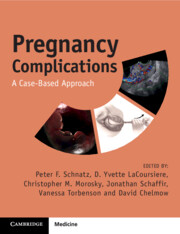Book contents
- Pregnancy Complications
- Pregnancy Complications
- Copyright page
- Contents
- Contributors
- Preface
- Note from the Editor-in-Chief
- Normal Laboratory Values (Conventional Units) []
- Section 1 Antepartum (Early Pregnancy)
- Section 2 Antepartum (Mid-trimester)
- Section 3 Antepartum (Late Pregnancy)
- Section 4 Antepartum (Medical Complications)
- Section 5 Antepartum (Infectious Complications)
- Section 6 Intrapartum/Delivery
- Case 46 A 40-Year-Old at 41 Weeks with a Closed Cervix after 12 Hours of Induction
- Case 47 A 25-Year-Old at 39 Weeks’ Gestation Presents with Regular Contractions and Minimal Cervical Change
- Case 48 A 35-Year-Old at 40 Weeks with Ruptured Membranes and Arrest of Cervical Dilation at 7 cm for 3 Hours
- Case 49 A 30-Year-Old at 36 Weeks’ Gestation with Breech Presentation
- Case 50 A 25-Year-Old at 39 Weeks’ Gestation with Brow Presentation at 9 cm Dilation
- Case 51 A 30-Year-Old at 39 Weeks’ Gestation with Fever in Labor
- Case 52 A 20-Year-Old at 39 Weeks’ Gestation with Persistent Occiput Posterior Presentation, Arrest of Descent, and Worsening Fetal Heart Rate Tracing
- Case 53 A 25-Year-Old at 40 Weeks’ Gestation with a Cesarean Delivery after a Failed Vacuum
- Case 54 A 25-Year-Old at 40 Weeks’ Gestation with Broad Ligament Extension during Cesarean Delivery
- Case 55 A 25-Year-Old at 40 Weeks’ Gestation with Urine Noted in Operative Field during Repeat Cesarean
- Case 56 A 20-Year-Old with a Fourth-Degree Perineal Laceration
- Case 57 A 25-Year-Old at 39 Weeks’ Gestation with Abdominal Pain, Vaginal Bleeding, and Worsening Fetal Heart Rate Tracing during TOLAC
- Case 58 A 40-Year-Old at 39 Weeks’ Gestation Becomes Unresponsive during the Second Stage of Labor
- Case 59 A 45-Year-Old at 39 Weeks’ Gestation Presents in Ventricular Fibrillation Undergoing CPR
- Case 60 A 35-Year-Old with a Vaginal Mass and Hemorrhage Immediately after Delivery
- Case 61 A 30-Year-Old with an Undelivered Placenta 30 Minutes Following Delivery
- Case 62 A 30-Year-Old at 38 Weeks’ Gestation with “Turtle Sign” Noted at Delivery
- Section 7 Postpartum
- Section 8 Fetal Complications
- Section 9 Placental Complications
- Section 10 Complications of the Cord, Amnion, and Gravid Uterus
- Section 11 Psychosocial Considerations
- Index
- References
Case 50 - A 25-Year-Old at 39 Weeks’ Gestation with Brow Presentation at 9 cm Dilation
from Section 6 - Intrapartum/Delivery
Published online by Cambridge University Press: 08 April 2025
- Pregnancy Complications
- Pregnancy Complications
- Copyright page
- Contents
- Contributors
- Preface
- Note from the Editor-in-Chief
- Normal Laboratory Values (Conventional Units) []
- Section 1 Antepartum (Early Pregnancy)
- Section 2 Antepartum (Mid-trimester)
- Section 3 Antepartum (Late Pregnancy)
- Section 4 Antepartum (Medical Complications)
- Section 5 Antepartum (Infectious Complications)
- Section 6 Intrapartum/Delivery
- Case 46 A 40-Year-Old at 41 Weeks with a Closed Cervix after 12 Hours of Induction
- Case 47 A 25-Year-Old at 39 Weeks’ Gestation Presents with Regular Contractions and Minimal Cervical Change
- Case 48 A 35-Year-Old at 40 Weeks with Ruptured Membranes and Arrest of Cervical Dilation at 7 cm for 3 Hours
- Case 49 A 30-Year-Old at 36 Weeks’ Gestation with Breech Presentation
- Case 50 A 25-Year-Old at 39 Weeks’ Gestation with Brow Presentation at 9 cm Dilation
- Case 51 A 30-Year-Old at 39 Weeks’ Gestation with Fever in Labor
- Case 52 A 20-Year-Old at 39 Weeks’ Gestation with Persistent Occiput Posterior Presentation, Arrest of Descent, and Worsening Fetal Heart Rate Tracing
- Case 53 A 25-Year-Old at 40 Weeks’ Gestation with a Cesarean Delivery after a Failed Vacuum
- Case 54 A 25-Year-Old at 40 Weeks’ Gestation with Broad Ligament Extension during Cesarean Delivery
- Case 55 A 25-Year-Old at 40 Weeks’ Gestation with Urine Noted in Operative Field during Repeat Cesarean
- Case 56 A 20-Year-Old with a Fourth-Degree Perineal Laceration
- Case 57 A 25-Year-Old at 39 Weeks’ Gestation with Abdominal Pain, Vaginal Bleeding, and Worsening Fetal Heart Rate Tracing during TOLAC
- Case 58 A 40-Year-Old at 39 Weeks’ Gestation Becomes Unresponsive during the Second Stage of Labor
- Case 59 A 45-Year-Old at 39 Weeks’ Gestation Presents in Ventricular Fibrillation Undergoing CPR
- Case 60 A 35-Year-Old with a Vaginal Mass and Hemorrhage Immediately after Delivery
- Case 61 A 30-Year-Old with an Undelivered Placenta 30 Minutes Following Delivery
- Case 62 A 30-Year-Old at 38 Weeks’ Gestation with “Turtle Sign” Noted at Delivery
- Section 7 Postpartum
- Section 8 Fetal Complications
- Section 9 Placental Complications
- Section 10 Complications of the Cord, Amnion, and Gravid Uterus
- Section 11 Psychosocial Considerations
- Index
- References
Summary
Although rare, nonvertex cephalic presentations can present to labor and delivery at any gestation. It is important to be able to describe and understand the mechanics as well as risks to these malpresentations in order to be able to counsel patients and decrease maternal and neonatal complications. There are significant differences in the fetal skull diameters and with persistent brow presentation there is a risk of fetal trauma or hypoxic injury. Persistent mentum posterior and brow presentations require cesarean delivery. Informed consent should be obtained, and parents should be aware of the risks of fetal compromise based on malpresentation. Given the natural mechanics of labor, some patients remain great candidates for vaginal birth. However, in certain scenarios, patients will warrant surgical intervention with cesarean delivery.
Keywords
Information
- Type
- Chapter
- Information
- Pregnancy ComplicationsA Case-Based Approach, pp. 152 - 153Publisher: Cambridge University PressPrint publication year: 2025
